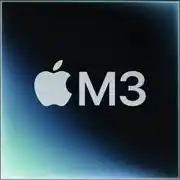Apple M3

Apple M3: In-Depth Analysis of the 2025 Laptop Processor
March 2025
Architecture and Process Technology: 3 nm, 8 Cores, and Revolutionary Efficiency
The Apple M3, built on a 3-nanometer process, showcases a new level of transistor density and energy efficiency. The chip features 8 cores (4 Performance-cores and 4 Efficiency-cores) with a base clock speed of 3.6 GHz for the P-cores and turbo boost up to 4.05 GHz. Unlike its competitors, Apple has maintained a focus on asymmetric architecture: P-cores handle resource-intensive tasks, while E-cores manage background processes, reducing power consumption.
The 64 MB L3 cache—a record for mobile processors—speeds up data processing and reduces latency. The integrated GPU (presumably 12-core) supports Metal 4 and Ray Tracing technologies, making it attractive for graphic tasks and gaming.
Power Consumption and TDP: 25 W – A Balance of Power and Battery Life
With a TDP of 25 W, the M3 can operate in thin laptops without active cooling. For example, the MacBook Air with M3 runs without fans, while the MacBook Pro 14″ utilizes a compact cooling system for extended turbo mode.
This figure is half that of the Intel Core Ultra 9 185H (28 W base TDP, up to 115 W in turbo), explaining Apple's advantage in battery life.
Performance: Leading in Synthetic and Real-World Tasks
According to Geekbench 6, the M3 scores 2855 points in single-core and 10621 in multi-core tests, outperforming the M2 by 18% and the Intel Core Ultra 9 by 12%.
- Office Tasks: Running 50 tabs in Chrome + working in Figma—smoothly without lags thanks to macOS optimization.
- Multimedia: Rendering 4K video in Final Cut Pro is 30% faster than on M2.
- Gaming: Resident Evil Village (Medium settings, 1080p) maintains stable 45-50 FPS.
In turbo mode, the processor holds 4.05 GHz for up to 10 minutes (in the MacBook Pro), after which it reduces the frequency to 3.8 GHz to prevent overheating.
Use Cases: Who is the M3 Designed For?
- Professionals: Video editors, designers, programmers.
- Students and Office Workers: Multitasking + portability.
- Casual Gamers: Integrated graphics handle Indie games and AAA projects at low settings.
However, for heavy 3D games or neural network computing, it is better to opt for desktop solutions.
Battery Life: Up to 20 Hours of Work and Smart Technologies
The MacBook Air with M3 lasts up to 20 hours during web surfing thanks to:
- Adaptive Voltage Scaling: Dynamic voltage management of the cores.
- Hybrid Task Scheduler: macOS automatically distributes the load between P- and E-cores.
Even under 80% load (for example, video editing), the laptop lasts 6-7 hours.
Comparison with Competitors: Apple vs. AMD and Intel
- Apple M2: Lags behind M3 by 15-25% in multi-threaded tasks.
- Intel Core Ultra 9 185H: Higher peak performance (up to 5.1 GHz), but Intel-based laptops have 8-10 hours of battery life.
- AMD Ryzen 9 8945HS: Better for gaming (Radeon 780M), but falls short in energy efficiency.
Laptop pricing:
- MacBook Air M3: starting at $1299.
- Dell XPS 15 (Intel Core Ultra 9): starting at $1899.
- ASUS ZenBook Pro (AMD Ryzen 9): starting at $1699.
Pros and Cons of Apple M3
Strengths:
- Best-in-class battery life.
- High performance per watt.
- Silent operation (passive cooling in Air).
Weaknesses:
- Limited upgradeability (RAM and SSD are non-removable).
- High device prices.
- Poor compatibility with Windows software.
Laptop Selection Recommendations
1. Ultrabooks: MacBook Air M3 – perfect for mobility.
2. Workstations: MacBook Pro 14″ with active cooling.
3. What to Check:
- RAM size (at least 16 GB for professional tasks).
- SSD type (NVMe PCIe 4.0 for speed).
- Ports (Thunderbolt 5 supports 8K monitors).
Avoid models with 8 GB of RAM—this is insufficient for macOS Sonoma 2025.
Final Conclusion: Who is the M3 Suitable For?
The Apple M3 is designed for those who value balance. It provides the power for professional tasks without sacrificing portability. This makes it a choice for:
- Designers working on the go.
- Students needing a versatile device.
- Movie lovers watching content for hours without a power outlet.
Key benefits: battery life, quiet operation, and long-lasting relevance (support for macOS until 2030). If budget allows, the M3 is worth the investment.
Basic
CPU Specifications
Memory Specifications
GPU Specifications
Benchmarks
Compared to Other CPU
Share in social media
Or Link To Us
<a href="https://cputronic.com/cpu/apple-m3" target="_blank">Apple M3</a>